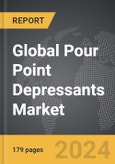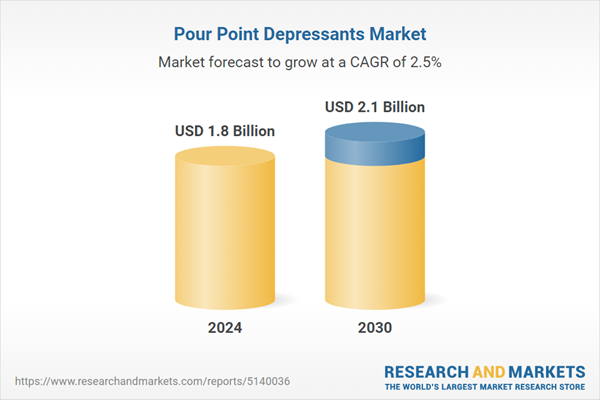Global Pour Point Depressants Market - Key Trends and Drivers Summarized
Pour Point Depressants: Enhancing Fuel Performance in Cold Climates
Pour point depressants (PPDs) are chemical additives used to lower the pour point of lubricants and fuels, ensuring their flowability at low temperatures. These additives are essential for maintaining the performance and reliability of engines and machinery in cold climates, where low temperatures can cause fuels and lubricants to solidify or become too viscous. By preventing the formation of wax crystals in fuels and improving the low-temperature properties of lubricants, PPDs ensure that engines and machinery can start and operate efficiently in cold conditions. Pour point depressants are widely used in various industries, including automotive, aviation, marine, and industrial applications, where they play a crucial role in optimizing the performance and longevity of equipment.How Are Technological Advancements Enhancing Pour Point Depressants?
Technological advancements have significantly improved the formulation and effectiveness of pour point depressants. Innovations in polymer chemistry have led to the development of advanced PPDs with enhanced efficiency in modifying wax crystal formation and improving low-temperature flow properties. These new formulations offer better performance at lower dosages, reducing the overall additive costs. Advances in additive compatibility have ensured that PPDs can be used in a wide range of fuel and lubricant formulations without adversely affecting other performance properties. The integration of PPDs with multifunctional additive packages has enhanced their utility, providing additional benefits such as improved fuel stability, reduced engine deposits, and enhanced wear protection. These technological improvements have expanded the applications and benefits of pour point depressants, making them indispensable in modern fuel and lubricant formulations.What Are the Key Applications and Benefits of Pour Point Depressants?
Pour point depressants are used in various applications across different industries, offering numerous benefits that enhance the performance and reliability of fuels and lubricants. In the automotive industry, PPDs are essential for ensuring the flowability of engine oils, transmission fluids, and diesel fuels in cold climates, preventing engine starting issues and wear during cold starts. In aviation, PPDs are used in jet fuels to maintain their flow properties at high altitudes and low temperatures, ensuring the reliable operation of aircraft engines. Marine and industrial applications also benefit from PPDs, which help maintain the performance of lubricants and fuels used in ships, machinery, and equipment operating in cold environments. The primary benefits of pour point depressants include improved low-temperature performance, enhanced fuel and lubricant stability, and reduced wear and maintenance costs, contributing to the overall efficiency and reliability of engines and machinery.What Factors Are Driving the Growth in the Pour Point Depressants Market?
The growth in the pour point depressants market is driven by several factors. The increasing demand for high-performance fuels and lubricants that can operate efficiently in cold climates is a significant driver, boosting the need for effective PPDs. Technological advancements that enhance the formulation, efficiency, and compatibility of PPDs are also propelling market growth. The expansion of the automotive, aviation, marine, and industrial sectors, where PPDs are widely used, is driving the demand for these additives. Additionally, the growing focus on fuel efficiency and engine performance, coupled with the need to reduce maintenance costs and downtime, is contributing to the increased use of pour point depressants. The rising awareness of the benefits of using high-quality additives in fuels and lubricants is further boosting market growth. These factors, coupled with the increasing availability of innovative and cost-effective PPD solutions, are driving the sustained growth of the pour point depressants market.Report Scope
The report analyzes the Pour Point Depressants market, presented in terms of market value (USD Thousand). The analysis covers the key segments and geographic regions outlined below.Segments
End-Use (Lubricant Industry, Oil & Gas Industry).Geographic Regions/Countries
World; United States; Canada; Japan; China; Europe (France; Germany; Italy; United Kingdom; Spain; Russia; and Rest of Europe); Asia-Pacific (Australia; India; South Korea; and Rest of Asia-Pacific); Latin America (Argentina; Brazil; Mexico; and Rest of Latin America); Middle East (Iran; Israel; Saudi Arabia; United Arab Emirates; and Rest of Middle East); and Africa.Key Insights:
- Market Growth: Understand the significant growth trajectory of the Lubricant Industry End-Use segment, which is expected to reach $1.2 Billion by 2030 with a CAGR of a 2.2%. The Oil & Gas Industry End-Use segment is also set to grow at 3% CAGR over the analysis period.
- Regional Analysis: Gain insights into the U.S. market, valued at $463.3 Million in 2024, and China, forecasted to grow at an impressive 4.4% CAGR to reach $425.7 Million by 2030. Discover growth trends in other key regions, including Japan, Canada, Germany, and the Asia-Pacific.
Report Features:
- Comprehensive Market Data: Independent analysis of annual sales and market forecasts in USD from 2024 to 2030.
- In-Depth Regional Analysis: Detailed insights into key markets, including the U.S., China, Japan, Canada, Europe, Asia-Pacific, Latin America, Middle East, and Africa.
- Company Profiles: Coverage of major players such as Afton Chemical Corporation, Akzo Nobel NV, Chevron Corporation, Clariant Chemicals (India) Ltd., Croda International PLC and more.
- Complimentary Updates: Receive free report updates for one year to keep you informed of the latest market developments.
Why You Should Buy This Report:
- Detailed Market Analysis: Access a thorough analysis of the Global Pour Point Depressants Market, covering all major geographic regions and market segments.
- Competitive Insights: Get an overview of the competitive landscape, including the market presence of major players across different geographies.
- Future Trends and Drivers: Understand the key trends and drivers shaping the future of the Global Pour Point Depressants Market.
- Actionable Insights: Benefit from actionable insights that can help you identify new revenue opportunities and make strategic business decisions.
Key Questions Answered:
- How is the Global Pour Point Depressants Market expected to evolve by 2030?
- What are the main drivers and restraints affecting the market?
- Which market segments will grow the most over the forecast period?
- How will market shares for different regions and segments change by 2030?
- Who are the leading players in the market, and what are their prospects?
Some of the 11 major companies featured in this Pour Point Depressants market report include:
- Afton Chemical Corporation
- Akzo Nobel NV
- Chevron Corporation
- Clariant Chemicals (India) Ltd.
- Croda International PLC
- Evonik Industries AG
- Innospec, Inc.
- Sanyo Chemical Industries Ltd.
- The Lubrizol Corporation
Table of Contents
Companies Mentioned (Partial List)
A selection of companies mentioned in this report includes, but is not limited to:
- Afton Chemical Corporation
- Akzo Nobel NV
- Chevron Corporation
- Clariant Chemicals (India) Ltd.
- Croda International PLC
- Evonik Industries AG
- Innospec, Inc.
- Sanyo Chemical Industries Ltd.
- The Lubrizol Corporation
Table Information
| Report Attribute | Details |
|---|---|
| No. of Pages | 179 |
| Published | April 2025 |
| Forecast Period | 2024 - 2030 |
| Estimated Market Value ( USD | $ 1.8 Billion |
| Forecasted Market Value ( USD | $ 2.1 Billion |
| Compound Annual Growth Rate | 2.5% |
| Regions Covered | Global |









